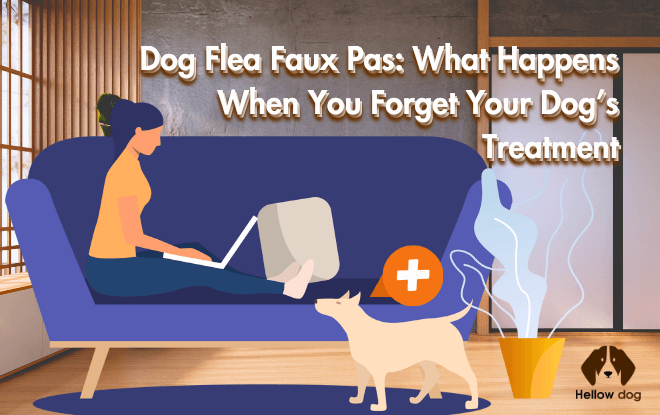As a dog owner, keeping your furry friend healthy and happy is a top priority. That means staying on top of preventative care like flea and tick treatment. But let’s face it – life gets busy. It’s not unusual for a pet owner to accidentally forget or miss their dog’s monthly flea treatment. All pet owners make blunders occasionally, but it’s essential to understand the consequences so you can get your pup the care they need if you do slip up.
So, what happens if you miss one dog flea treatment? Continue reading to find out.
The Trouble Starts Right Away
The sad truth is that, with fleas, you can never let your guard down. As small as they are, they can be hard to eliminate once infestation starts.
Fleas are highly prolific pests. The average female flea can lay 40 eggs per day, which means that with just one egg-laying insect, a home could be heavily infested by about 20,000 fleas in just 60 days. The eggs also hatch quickly, usually within the first two weeks of being laid. With these numbers, it’s easy to see how quickly a flea infestation problem can spiral out of control.
They also jump high, up to 13 inches. So, a dog flea can quickly jump around the house, causing thousands of biting and sucking among pets and humans alike. Once they gain access, fleas will inevitably multiply in your carpets, bedding, and upholstery.
Without continued flea prevention, your dog can become reinfested again and again. Not only does this lead to miserable flea allergy and anemia for your dog, but also significant frustration and expense getting the infestation under control once it has spread through your home.

Itching, Scratching, Biting
Flea saliva contains compounds that provoke a strong immune reaction and skin irritation in dogs. As such, flea bites lead to symptoms like red skin, rashes, and hot spots from biting and gnawing at their skin, hair loss, scabs, and secondary infections. The acute itching from dog flea allergy is intensely frustrating and uncomfortable for dogs. Meanwhile, the flea problem is often distressing for owners who want to ease their pet’s suffering.
Left untreated, severe flea infestations can lead to dog flea allergy dermatitis. It occurs when a dog is repeatedly exposed to fleas, and the allergic reaction grows stronger. FAD is a severe skin disease associated with intense, unrelenting itching that requires steroids or other medications to control. Catching a flea problem before it escalates to this point is crucial.
Sucking Blood, Spreading Disease
Fleas feed on your pet’s blood, acting like little vampires that can suck up to 15 times their weight. Although a few dog fleas may not seem like an emergency, uncontrolled infestations over time can lead to potentially life-threatening flea-bite anemia. This scenario is hazardous in young puppies or dogs with compromised health.
Aside from the troublesome effects of fleas themselves, they can transmit several dangerous diseases to your dog, such as bartonellosis, tapeworms, and the bacterial infection murine typhus, among others. Several of these flea-borne illnesses can also pass to humans after a bite, putting your entire family’s health in jeopardy.
Hard to Find, Harder to Eliminate
Dealing with a heavy flea burden once it has spread into your home is extremely difficult. Just because you stop seeing fleas quickly hopping around on your dog does not mean the infestation is under control. Much of the flea population lives in the environment during pre-adult stages, not on your pet.
Dog flea eggs, larvae, and pupae hide out as they mature in the depths of carpeting, underneath furniture cushions, and tucked into the nooks and crannies that are hard for products to penetrate. Killing off this immature population is crucial for actual flea destruction but can be nearly impossible to accomplish entirely on your own.
Costly Clean Up
If you let your dog’s flea prevention lapse even for a month or two during warm weather, you will likely battle a significant flea problem at home. Getting a stubborn flea infestation under control almost always requires professional extermination services.
Imagine having to wipe out an entire population of fleas! The task is as big as it sounds, commonly including a line of attack like professional carpet cleaning, steam cleaning hard surfaces, extensive vacuuming, growth regulator spraying, and fogging with insecticides according to an expert protocol.
After a brief period of neglecting safe flea prevention, you could face hundreds of dollars in costs for extensive cleaning, flea baths and medication for your dog, over-the-counter sprays and foggers, replacement bedding and supplies, and boarding. At the same time, home remediation occurs, and more. Without a doubt, missing even one treatment can be a costly blunder for any household!
Prevent This Headache
With detrimental effects such as fast irritation, disease transmission, exponential population growth, and extreme hassle, a flea treatment isn’t just another appointment on your calendar. It’s your way out of all the trouble uncontrolled fleas can unleash in your home.
Gaining a better understanding helps highlight why consistent flea and tick prevention is vital for every pet parent. It protects your pup’s health, comfort, and even their life in some cases of flea bite anemia.
Given the nominal amount you must invest to prevent an infestation effectively, it’s the less painful route than attempting to “cure” a severe flea problem after the population explodes. Just like when you take your daily vitamins and medicines to prevent health issues, our pets depend on us to be diligent about their monthly preventative care.
Set alerts on your phone, mark them on your calendar, or find another system that helps you remember to stay on schedule. That way, you can continue seamlessly protecting your fur baby and avoid the headache, mess, and risks of attempting dog flea removal once they’ve already reached epidemic proportions untreated. Slacking for even one or two months can, quite literally, come back to bite!
Stay Vigilant Year-Round
In warm environments, fleas manage to survive all year long. So, vets recommend year-round flea and tick prevention, even during cooler months, for pets living in warm regions below the frost line. A temperature-controlled home can allow fleas to remain awake and actively bite outside of warmer seasons.
During hot summers, it only takes a brief window of opportunity for dormant flea eggs and larvae in your home to become activated again. Dropping your guard with prevention labelling winter “flea off-season” can create an unpleasant surprise!
Consistent cold snaps that freeze surface layers outdoors can substantially knock down flea populations in regions with actual winters for a few months. But once spring’s seasonal shift helps surface temperatures climb and stay above 45 degrees F, those flea and tick pests will rapidly rebound. Sticking firmly to year-round prevention timing is crucial where winters are flea fact: flea treatment is mild and inconsistent.
Choose Products Wisely
With the variety of dog flea and tick control products available both over the counter and via prescription from your vet, it can get confusing to determine what’s truly best for your dog. Do your homework before investing time and money in a product line. Ensure any preventative meets the following criteria:
- Safe ingredients and dosage for your dog’s size and age
- The product must contain an insect growth regulator (IGR) that kills eggs and inhibits the maturation of immature flea stages.
- Rapidly kills adult biting fleas plus repels new ones from attaching easily.
- Easy, pet-friendly application method
- Provides at least a month of protection with each dose
- Positive reputation and reviews among veterinary clients
Products meeting professional criteria provide the protection your pet needs. Over-the-counter, pet shops, or grocery store brands may help alleviate symptoms and discomfort. However, some may need more rigorous effectiveness and safety testing of better veterinary-recommended options. Don’t cut corners that could have costly or dangerous consequences for your dog down the road.

Ask Your Vet !
Have an open conversation with your veterinarian about your goals for protecting your unique dog from fleas and ticks. Factors like your dog’s lifestyle, climate, seasons, travel plans, health conditions, and more allow your vet to tailor the right prescription product plan to safeguard your pup’s well-being in the months ahead.
If you need help remembering monthly doses, have trouble affording prevention consistently, or have other barriers to administering products on cue, speak up! Your veterinary team has tons of experience devising solutions so clients can get their pets the preventative care essential to avoid detrimental, expensive pest problems at home.
Stay Diligent Moving Forward
While it’s easy to feel guilty after dropping the ball on dog flea prevention obligations, self-blame won’t fix the problem or prevent it from happening again. Instead, rededicate yourself to a thoughtful prevention plan for your dog’s health. Use this stumble as motivation to double down on diligent care that protects your pet and home from dangerous flea and tick infestations in all the months ahead.
Conclusion
Your furry friend depends on you to shield them from numerous threats in life. Although remembering a monthly schedule of pest prevention may feel tedious among busy modern demands, this small effort has huge payoffs for your dog’s comfort and well-being. By sticking to intelligent, adequate parasite protection chosen in partnership with your vet, you can keep your pet’s world happy, healthy, and dog flea-free for life.







